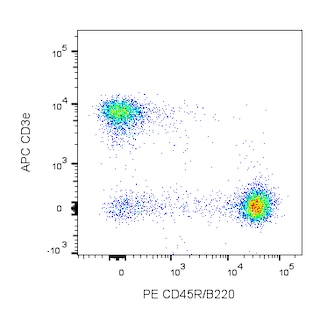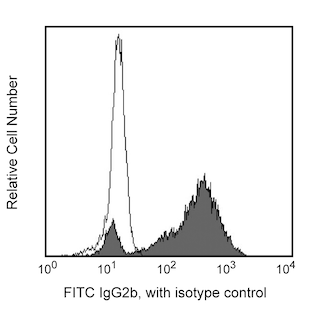-
Training
- Flow Cytometry Basic Training
-
Product-Based Training
- BD FACSDiscover™ S8 Cell Sorter Product Training
- Accuri C6 Plus Product-Based Training
- FACSAria Product Based Training
- FACSCanto Product-Based Training
- FACSLyric Product-Based Training
- FACSMelody Product-Based Training
- FACSymphony Product-Based Training
- HTS Product-Based Training
- LSRFortessa Product-Based Training
- Advanced Training
-
- BD FACSDiscover™ S8 Cell Sorter Product Training
- Accuri C6 Plus Product-Based Training
- FACSAria Product Based Training
- FACSCanto Product-Based Training
- FACSLyric Product-Based Training
- FACSMelody Product-Based Training
- FACSymphony Product-Based Training
- HTS Product-Based Training
- LSRFortessa Product-Based Training
- United States (English)
-
Change country/language
Old Browser
This page has been recently translated and is available in French now.
Looks like you're visiting us from {countryName}.
Would you like to stay on the current country site or be switched to your country?




Expression of CD21/CD35 on splenic B lymphocytes. BALB/c splenocytes were stained with PE-conjugated anti-mouse CD45R/B220 mAb RA3-6B2 (Cat. No. 553089/553090) and either purified rat IgG2b, κ isotype control mAb A95-1 (Cat. No. 553986, left panel) or purified mAb 7G6 (right panel), followed by FITC-conjugated anti-rat IgG2b mAb RG7/11.1 (Cat. No. 553900). Flow cytometry was performed on a BD FACScan™ flow cytometry system.


BD Pharmingen™ Purified Rat Anti-Mouse CD21/CD35

Regulatory Status Legend
Any use of products other than the permitted use without the express written authorization of Becton, Dickinson and Company is strictly prohibited.
Preparation And Storage
Product Notices
- Since applications vary, each investigator should titrate the reagent to obtain optimal results.
- Please refer to www.bdbiosciences.com/us/s/resources for technical protocols.
- Caution: Sodium azide yields highly toxic hydrazoic acid under acidic conditions. Dilute azide compounds in running water before discarding to avoid accumulation of potentially explosive deposits in plumbing.
- Sodium azide is a reversible inhibitor of oxidative metabolism; therefore, antibody preparations containing this preservative agent must not be used in cell cultures nor injected into animals. Sodium azide may be removed by washing stained cells or plate-bound antibody or dialyzing soluble antibody in sodium azide-free buffer. Since endotoxin may also affect the results of functional studies, we recommend the NA/LE (No Azide/Low Endotoxin) antibody format, if available, for in vitro and in vivo use.
Companion Products



The 7G6 antibody recognizes an epitope shared by 145-150-kDa and 190-kDa complement receptor proteins, originally designated CR2 (CD21) and CR1 (CD35), respectively. In the mouse, CD21 and CD35 are expressed on the majority of peripheral B lymphocytes, on the majority of resident peritoneal macrophages and mast cells, on peripheral blood granulocytes after treatment with N-formyl-Met-Leu-Phe, and on follicular dendritic cells, but not on thymocytes, T cells, erythrocytes, or platelets. CD21 is a ligand-binding component of the CD19/CD21/CD81 signal-transduction complex associated with the antigen receptor on B lymphocytes. CD21/CD35 also co-localizes with CD19 on the surface of peritoneal mast cells. Cr2null mice display impaired inflammatory and humoral immune responses in vivo. The 7G6 mAb has been reported to inhibit rosette formation by C3d-bearing sheep erythrocytes, to block the complement dependent trapping of immune complexes by follicular dendritic cells, and to down-regulate mouse CD21/CD35 expression upon in vivo application, thus inhibiting primary antibody responses to immunization. Co-stimulation of B-cell differentiation via Sepharose-coupled 7G6 antibody has also been observed. The 7G6 mAb recognizes an epitope on CD35 distinct from the epitope recognized by anti-mouse CD35, clone 8C12, and it does not block binding of 8C12 mAb to mouse CD35.
This antibody is routinely tested by flow cytometric analysis. Other applications were tested at BD Biosciences Pharmingen during antibody development only or reported in the literature.
Development References (20)
-
Ahearn JM, Fischer MB, Croix D, et al. Disruption of the Cr2 locus results in a reduction in B-1a cells and in an impaired B cell response to T-dependent antigen. Immunity. 1996; 4(3):251-262. (Biology). View Reference
-
Axcrona K, Gray D, Leanderson T. Regulation of B cell growth and differentiation via CD21 and CD40. Eur J Immunol. 1996; 26(9):2203-2207. (Clone-specific: (Co)-stimulation). View Reference
-
Cariappa A, Tang M, Parng C, et al. The follicular versus marginal zone B lymphocyte cell fate decision is regulated by Aiolos, Btk, and CD21. Immunity. 2001; 14(5):603-615. (Biology). View Reference
-
Dempsey PW, Allison ME, Akkaraju S, Goodnow CC, Fearon DT. C3d of complement as a molecular adjuvant: bridging innate and acquired immunity. Science. 1996; 287(5247):348-350. (Clone-specific: Blocking). View Reference
-
Fischer MB, Goerg S, Shen L, et al. Dependence of germinal center B cells on expression of CD21/CD35 for survival. Science. 1998; 280(5363):582-585. (Biology). View Reference
-
Gommerman JL, Oh DY, Zhou X, et al. A role for CD21/CD35 and CD19 in responses to acute septic peritonitis: a potential mechanism for mast cell activation. J Immunol. 2000; 165(12):6915-6921. (Biology). View Reference
-
Heyman B, Wiersma EJ, Kinoshita T. In vivo inhibition of the antibody response by a complement receptor-specific monoclonal antibody. J Exp Med. 1990; 172(2):665-668. (Clone-specific: Blocking). View Reference
-
Hu H, Martin BK, Weis JJ, Weis JH. Expression of the murine CD21 gene is regulated by promoter and intronic sequences. J Immunol. 1997; 158(10):4758-4768. (Biology). View Reference
-
Kinoshita T, Takeda J, Hong K, Kozono H, Sakai H, Inoue K. Monoclonal antibodies to mouse complement receptor type 1 (CR1). Their use in a distribution study showing that mouse erythrocytes and platelets are CR1-negative. J Immunol. 1988; 140(9):3066-3072. (Immunogen). View Reference
-
Kinoshita T, Thyphronitis G, Tsokos GC, et al. Characterization of murine complement receptor type 2 and its immunological cross-reactivity with type 1 receptor. Int Immunol. 1990; 2(7):651-659. (Clone-specific: Immunoprecipitation, Western blot). View Reference
-
Kurtz CB, O'Toole E, Christensen SM, Weis JH. The murine complement receptor gene family. IV. Alternative splicing of Cr2 gene transcripts predicts two distinct gene products that share homologous domains with both human CR2 and CR1. J Immunol. 1990; 144(9):3581-3591. (Biology). View Reference
-
Martin BK, Weis JH. Murine macrophages lack expression of the Cr2-145 (CR2) and Cr2-190 (CR1) gene products. Eur J Immunol. 1993; 23(11):3037-3042. (Biology). View Reference
-
Masuda A, Makino M, Kasajima T. Contribution of Thy-1-CD4+ T cells to the disorganization of lymphoid follicles in retrovirus-induced immunodeficiency syndrome, MAIDS. Clin Immunol Immunopathol. 1996; 81(3):253-260. (Clone-specific: Immunohistochemistry). View Reference
-
Molina H, Holers VM, Li B, et al. Markedly impaired humoral immune response in mice deficient in complement receptors 1 and 2. Proc Natl Acad Sci U S A. 1996; 93(8):3357-3361. (Biology). View Reference
-
Oliver AM, Martin F, Gartland GL, Carter RH, Kearney JF. Marginal zone B cells exhibit unique activation, proliferative and immunoglobulin secretory responses. Eur J Immunol. 1997; 27(9):2366-2374. (Biology). View Reference
-
Oliver AM, Martin F, Kearney JF. IgMhighCD21high lymphocytes enriched in the splenic marginal zone generate effector cells more rapidly than the bulk of follicular B cells. J Immunol. 1999; 162(12):7198-7207. (Biology). View Reference
-
Tedder TF, Zhou LJ, Engel P. The CD19/CD21 signal transduction complex of B lymphocytes. Immunol Today. 1994; 15(9):437-442. (Biology). View Reference
-
Thyphronitis G, Kinoshita T, Inoue K, et al. Modulation of mouse complement receptors 1 and 2 suppresses antibody responses in vivo. J Immunol. 1991; 147(1):224-230. (Clone-specific: Blocking). View Reference
-
Wiersma EJ, Kinoshita T, Heyman B. Inhibition of immunological memory and T-independent humoral responses by monoclonal antibodies specific for murine complement receptors. Eur J Immunol. 1991; 21(10):2501-2506. (Clone-specific: Blocking). View Reference
-
Yoshida K, van den Berg TK, Dijkstra CD. Two functionally different follicular dendritic cells in secondary lymphoid follicles of mouse spleen, as revealed by CR1/2 and FcR gamma II-mediated immune-complex trapping. Immunology. 1993; 80(1):34-39. (Biology). View Reference
Please refer to Support Documents for Quality Certificates
Global - Refer to manufacturer's instructions for use and related User Manuals and Technical data sheets before using this products as described
Comparisons, where applicable, are made against older BD Technology, manual methods or are general performance claims. Comparisons are not made against non-BD technologies, unless otherwise noted.
For Research Use Only. Not for use in diagnostic or therapeutic procedures.
Report a Site Issue
This form is intended to help us improve our website experience. For other support, please visit our Contact Us page.